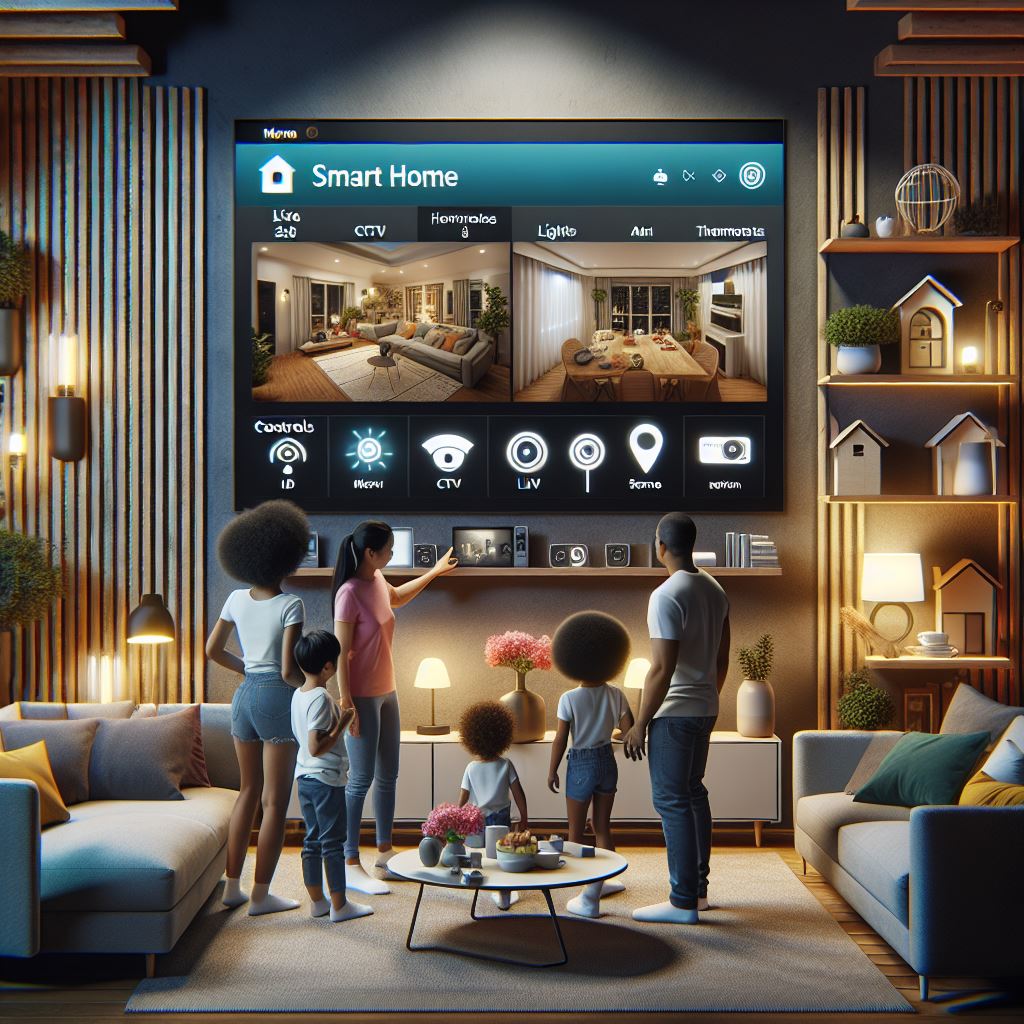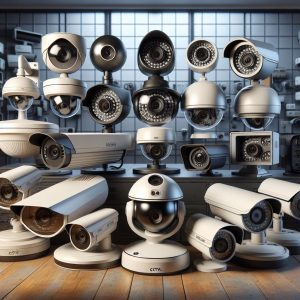In today’s increasingly connected world, smart home devices are transforming the way we manage and protect our homes; from convenient automation to enhanced security features, these devices offer a powerful way to improve home security.
Integrating CCTV with other smart home devices is a transformative step towards creating a more secure, efficient, and convenient living environment. By connecting your CCTV system with devices like smart locks, lights, and alarms, you can enhance your home’s security and automate responses to potential threats. For instance, if your CCTV detects motion, it can trigger smart lights to turn on, or send an alert to your smartphone, allowing you to monitor and respond in real-time. This integration not only provides peace of mind but also streamlines daily routines, making your home smarter and more responsive to your needs.
The Evolution of Smart Home Technology
Smart home technology refers to a home setup where appliances and devices can be automatically controlled remotely from anywhere with an internet connection using a mobile or other networked device.
Devices in a smart home are interconnected through the internet, allowing the user to control functions such as security access to the home, temperature, lighting, and a home theatre remotely.
Advancements in Home Security Systems
Significant technological advancements have marked the journey of home security systems. Traditional systems relied heavily on basic alarm mechanisms and professional monitoring services.
However, with the advent of the Internet of Things (IoT), home security has evolved into a sophisticated network of interconnected devices. This shift has enabled real-time monitoring, remote control, and automation, transforming how we protect our homes.
Why integrate smart devices with your home security system?
Smart home devices bring individual advantages like energy efficiency and convenience. Yet, combining them with a home security system amplifies these benefits, creating a more robust and comprehensive security solution.
This integration upgrades a standard security setup to a smart one, enabling real-time monitoring, automated responses, and greater control over home security aspects.
Types of Smart Devices for Home Security Integration
Combining smart home devices with your security system transforms basic protective measures into a dynamic, interactive shield around your home. Smart devices such as cameras, lights, and locks do more than perform their individual tasks; when synchronized with your home security system, they enhance overall safety and efficiency. Critical components and their integration include the following:
- Smart Doorbell Cameras: A smart doorbell camera installed at your front door provides an extra layer of security by allowing you to see who is at your door before opening it. These devices can send motion sensor alerts, store previous footage, and remotely communicate with visitors. Connecting them to your home security system allows you to manage all these features through a single app.
- Smart Cameras: Smart cameras offer live streaming and recorded video, inside and outside the home, accessible from anywhere. These cameras can be linked to the home security system for integrated motion alerts and automated recording, providing a comprehensive view of home activity. Some smart cameras can send alerts that can distinguish between a person, vehicle or an animal.
- Smart Locks: Smart locks eliminate the need for physical keys and enhance entry security. Homeowners can set unique entry codes for family members and manage access remotely. Integration with home security systems allows for automated locking and alarm activation, further reinforcing security.
- Enhanced Automation with Smart Lights and Outlets: Smart lights and outlets can be controlled remotely, helping to save energy and improve convenience. Integration with security systems allows for routines like automatically turning on lights when a camera or sensor in that area detects a person. You can also have the lights turn off automatically based on a schedule or when you arm your system at night.
- Climate Control with Smart Thermostats: Smart thermostats adjust the home’s temperature based on presence, enhancing comfort and efficiency. Linking these with security systems can automate temperature adjustments based on security settings, such as lowering the thermostat when the system is armed at night.
- Smart Smoke Detectors: Integrating smart smoke detectors with a home security system ensures that any alerts are not only heard, but also managed through the system’s interface. These devices can activate lights to illuminate paths in case of an emergency, and can be silenced remotely if triggered by non-emergency events. If a smoke detector does detect a fire you can also have your smart thermostat automatically shut off and your smart locks can automatically unlock the doors to your property.
- Smart Garage Door Openers: Smart garage door openers and sprinkler controllers can also integrate with your system, ensuring doors are closed and even using water as a deterrent to clear your property when security alarms are activated.
- Virtual Assistants: Virtual assistants like Siri and Alexa can be integrated with home security systems to enable voice-controlled management of smart devices. Users can set up routines to control lighting, activate security settings, and manage other smart devices through simple voice commands, further simplifying home management.
- Streamlined Control and Interaction: A unified management platform integrates these devices, offering a streamlined user experience that simplifies daily interactions and enhances the efficiency of home management. This integration not only saves time but also extends the capabilities of each individual device through cooperative action.
Assessing Your Home Security Needs
Before integrating CCTV and smart home systems, it’s crucial to assess your home security needs. Consider factors like the size of your home, the number of entry points, and the level of security you desire. It’s also important to think about the integration of various security components, like alarms, cameras, and smart locks, to create a cohesive system. By thoroughly understanding your unique security needs, you can make informed decisions about the best solutions to implement, providing peace of mind and enhanced protection.
Selecting the Right CCTV System for Smart Home Integration
When choosing a CCTV system for smart home integration, consider the following:
- Compatibility: Ensure the CCTV system is compatible with your smart home devices.
- Connectivity: Look for systems that offer Wi-Fi or other wireless connections.
- Resolution: High-resolution cameras provide clearer images.
- Storage: Decide on cloud storage vs. local storage options
It’s also important to consider the complexity of the smart home and CCTV system you require. Generally, the more complex the system, the more important it is that you consult a professional to install it for you. At Garrison Alarms we offer expert installation.
Step-by-Step Guide to Integrating CCTV with Smart Home Devices
Step 1: Choose a Smart CCTV Camera
- Select a camera that aligns with your home’s needs and your smart home system’s capabilities.
Step 2: Set Up and Connect
- Install your CCTV cameras and connect them to your home Wi-Fi network.
Step 3: Integrate with Smart Home Platform
- Use your smart home platform’s app or interface to connect and control your new smart CCTV for home.
Step 4: Customise Settings
- Adjust settings such as motion detection sensitivity, alert types, and camera angles.
Benefits of Combining CCTV with Smart Home Systems
Integrating CCTV with your smart home brings several benefits:
- Enhanced Security: Real-time surveillance and instant alerts.
- Convenience: Manage security settings from anywhere.
- Energy Efficiency: Automated systems reduce unnecessary power usage.
- Peace of Mind: Constant monitoring provides assurance of safety.
The integration of smart CCTV cameras into home automation systems is not just a trend, it’s a significant step forward in home security.
Advantages and Challenges of CCTV-Smart Home Integration
Integrating CCTV and smart home technology offers numerous advantages:
- Remote Monitoring: Access live feeds from anywhere.
- Automated Responses: Set up your system to react automatically to certain triggers.
- Integrated Alerts: Receive notifications on your smartphone or device.
Future Trends in Home Automation and Security
The future of home automation and security is promising, with trends indicating:
- Increased AI Integration: Smart CCTV cameras will become more intelligent, offering features like facial recognition and unusual activity detection.
- Greater Interconnectivity: Enhanced integration between different smart home devices and systems.
- User-Friendly Interfaces: Easier and more intuitive control of smart home security systems, including CCTV integration.
- Expansion of Solar technology: The rise in usage of solar security cameras is set to give homeowners better options when it comes to installing outdoor cameras.
Making an Informed Purchase Decision
When considering the addition of a smart CCTV system to your home, it’s essential to make an informed purchase decision.
Here are key factors to consider:
- System Compatibility: Ensure the CCTV system is compatible with your existing smart home devices.
- Installation Requirements: Understand the installation process and whether professional assistance is needed.
- Budget Considerations: Balance the cost of the system with the features and benefits it offers.
Conclusion
Integrating CCTV with smart home technology is not just a step towards enhanced security; it’s a move towards a more connected, efficient, and responsive living environment. The integration of CCTV into a smart home system is undoubtedly a valuable addition for any homeowner.
For those looking to dive deeper into the world of home security and smart technology, visit Garrison Alarms or call 0800 427 747. We at GarrisonAlarms valued your safety. Get a FREE quote today!





